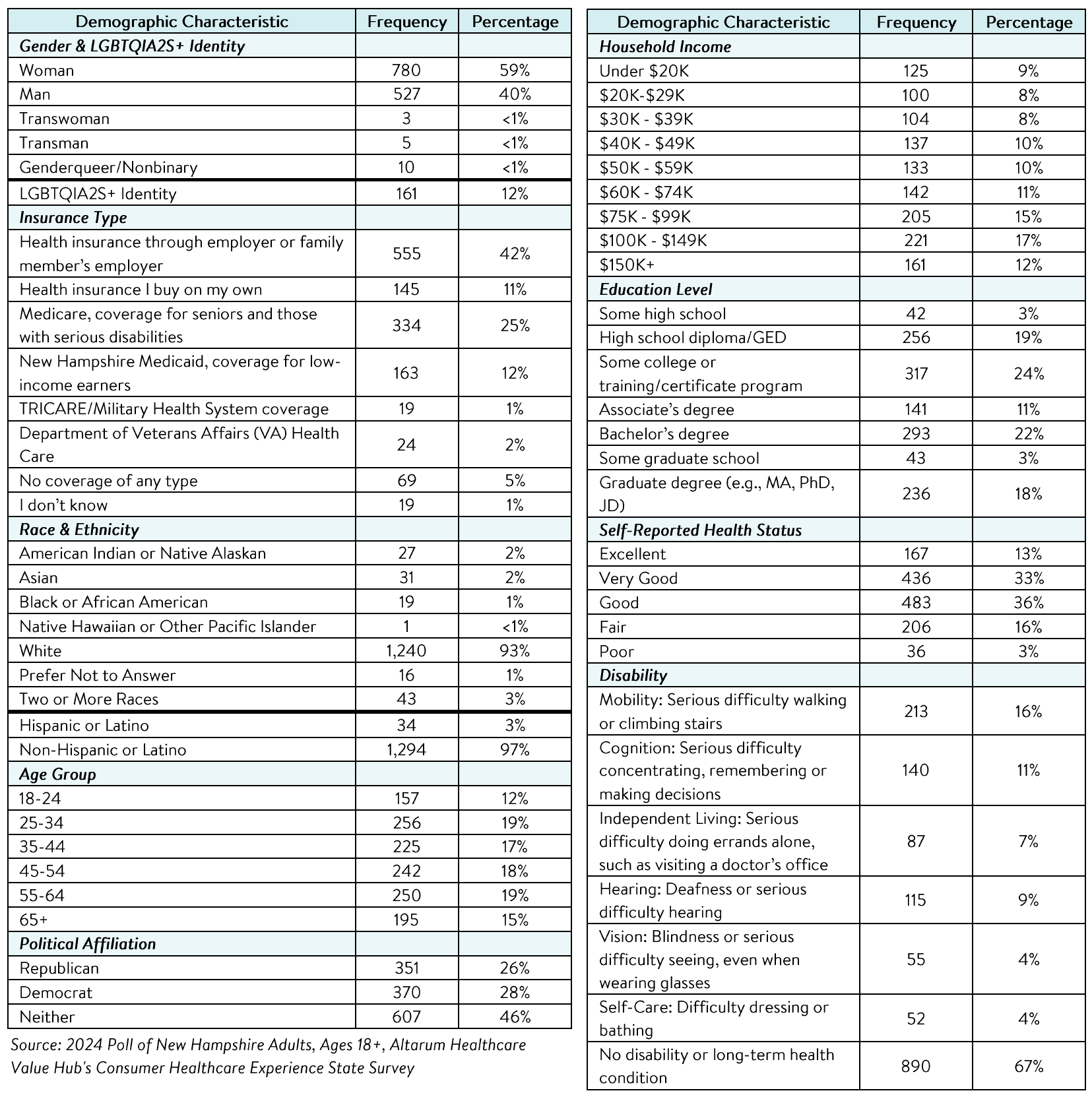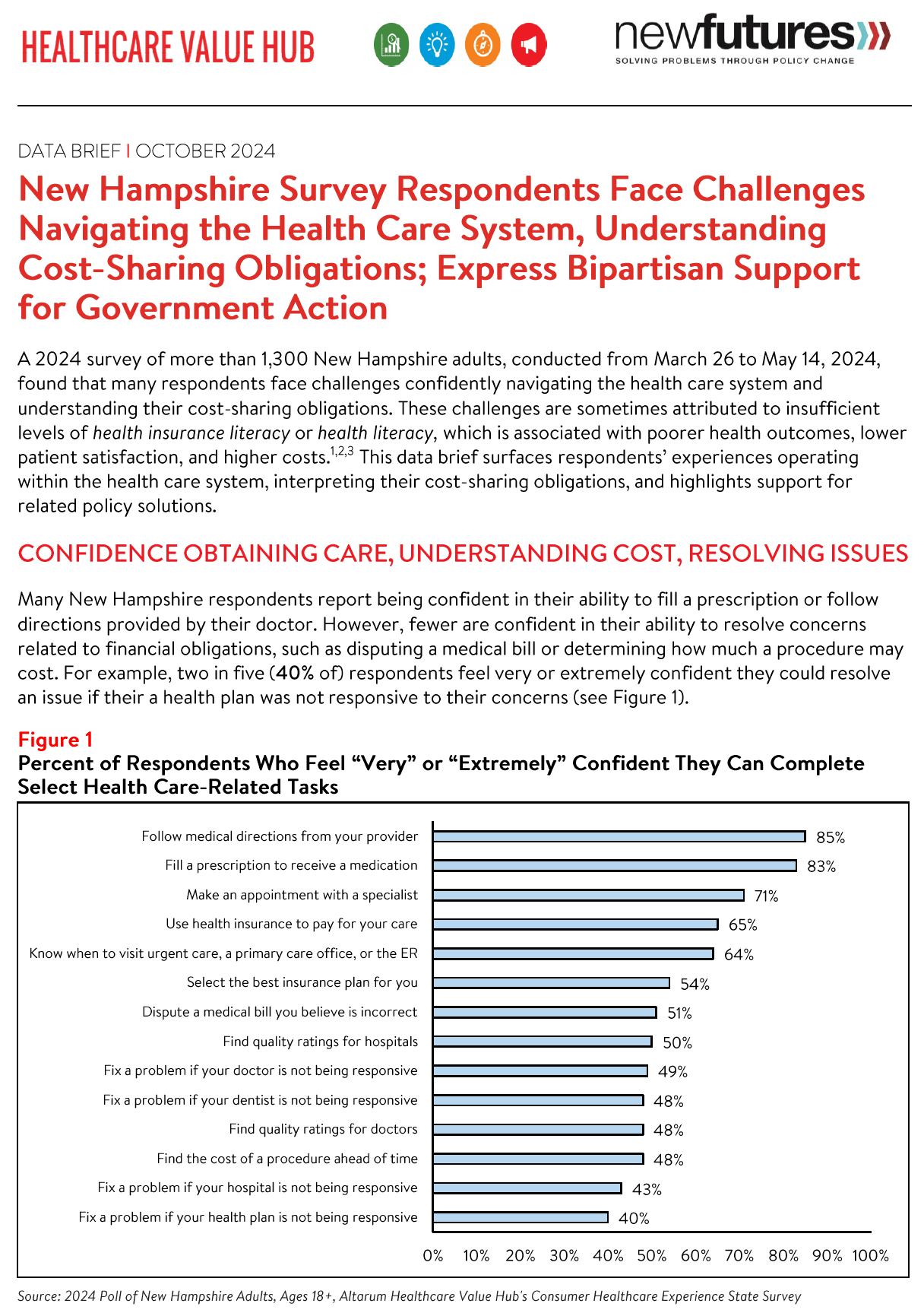New Hampshire Survey Respondents Face Challenges Navigating the Health Care System, Understanding Cost-Sharing Obligations; Express Bipartisan Support for Government Action
A 2024 survey of more than 1,300 New Hampshire adults, conducted from March 26 to May 14, 2024,
found that many respondents face challenges confidently navigating the health care system and
understanding their cost-sharing obligations. These challenges are sometimes attributed to insufficient
levels of health insurance literacy or health literacy, which is associated with poorer health outcomes, lower patient satisfaction, and higher costs.1,2,3 This data brief surfaces respondents' experiences operating within the health care system, interpreting their cost-sharing obligations, and highlights support for related policy solutions.
Confidence in Obtaining Care, Understanding Cost, Resolving Issues
Many New Hampshire respondents report being confident in their ability to fill a prescription or follow
directions provided by their doctor. However, fewer are confident in their ability to resolve concerns
related to financial obligations, such as disputing a medical bill or determining how much a procedure may
cost. For example, two in five (40% of) respondents feel very or extremely confident they could resolve
an issue if their a health plan was not responsive to their concerns (see Figure 1).

Finding/Interpreting Health Care Cost and Quality Information
Limited knowledge of health care quality or costs can hinder consumers' ability to budget for care, which
can be especially detrimental to the under- and un-insured.4 Among New Hampshire respondents, fewer
than half (48%) of respondents feel confident in their ability to find the cost of a procedure in advance. In
fact, among those who reported that they did not search for cost or quality information before a needed
procedure, 26% reported that the act of looking for information felt confusing or overwhelming, and 23%
reported that they did not know where to look.
Although most respondents who searched for cost or quality information were successful, there were
some who reported that they were unable to find the information they needed (see Figure 2). Over two in
five (42% of) respondents who searched for, but could not find, hospital cost information reported that
the available cost information was confusing, 32% reported that their provider or hospital would not
provide a price estimate, 30% reported that their insurer would not provide a price estimate, and 27%
reported that the price information was insufficient.
Likewise, among respondents who were unsuccessful in their search for hospital quality information, 26%
reported that the resources were confusing, and 20% reported that the quality information was not
sufficient. Notably, a small number of respondents reported that cost or quality is unimportant to them
(10 and 4%, respectively). These challenges persist despite federal hospital price transparency mandates.5

Research shows little correlation between the quality and the price of medical services.6 However, 42% of
respondents reported that they would be willing to pay more to see a doctor with higher quality rankings.
Additionally, 60% of New Hampshire respondents reported that the out-of-pocket costs would a "very" or
"extremely" important deciding factor if they had to choose between two providers with similar quality
ratings. Similarly, 56% reported that quality ratings are an important factor when deciding between two
physicians providing services for the same price.
Difficulty Understanding Common Health Care Terms
Research indicates that nearly half of insured adults find at least one aspect of their insurance difficult to
understand, highlighting the need for efforts to improve health insurance literacy.7 When given multiple
choices, over three-quarters of respondents were able to correctly define "premium," (79%) "deductible,"
(80%) and "copay" (84%) (see Figure 3). However, fewer than half (47%) were able to accurately define
"coinsurance." Respondents with higher levels of education selected the correct definition more
frequently than those with lower levels of education (see Table 1). This is especially apparent among results for "coinsurance," with just over a quarter (27%) of those with some high school education and a high school diploma or GED selecting the correct definition, compared to over half (57%) of those with some graduate school education and a graduate degree selecting the correct definition (see Figure 4). Health insurance coverage terms are often complex and difficult to understand; ensuring terms are clearly
defined and information is easily accessible may help beneficiaries navigate the health system.



Unexpected Medical Bills
Thirty-two percent of New Hampshire respondents received a surprise medical bill in the past year.
Among those, respondents who purchase their own insurance (e.g., through the Marketplace) most
frequently reported receiving a surprise medical bill (42%), followed by respondents with employersponsored health insurance (34%), respondents with Medicaid coverage (28%), and respondents with Medicare coverage (25%).
When asked about the nature of their surprise medical bill, half (51%) of respondents reported that the
amount was higher than anticipated, and 40% reported that the bill was from a provider that they didn't
expect to receive a bill from. In smaller numbers,13% reported being charged out-of-network rates by a
provider they believed was in-network, 6% reported being charged for services they did not receive and
24% reported experiencing something else unexpected.
Beyond describing the nature of and/or reason the bill was unexpected, respondents also reported various attempts to resolve the issue. Of those who received an unexpected medical bill in the past year, more than two in five (43%) took more than one step in their attempt to resolve their unexpected medical.
Many contacted their health plan (49%) or provider (44%), some paid the bill without disputing it (17%),
and few (10%) filed an insurance appeal (see Table 2).

Only 30% of respondents with an unexpected medical bill indicated that the issue was resolved to their
satisfaction (see Table 3). Notably, satisfied respondents often reported employing more direct resolution
strategies, such as contacting their health plan, whereas respondents who reported being dissatisfied with
the resolution were more likely to have paid the original bill without disputing.

Regardless, the majority of respondents reported that they settled their bills by paying in full (27%) or
through a payment plan (25%), while a smaller number successfully negotiated a lower bill (9%) or had
their bill dismissed (8%) (see Table 4). In a small number of cases (<1%), respondents reported filing for
bankruptcy due to an unexpected medical bill. Some respondents (10%) also reported being contacted by
a collection agency, underscoring the critical need to address the high cost of health care across the
state.8

Support for Solutions Across Party Lines
The burden of health care costs and the widespread support for reform indicate that elected leaders and
other stakeholders must prioritize addressing these consumer challenges. New Hampshire respondents
overwhelmingly endorsed several transparency-oriented strategies, including:
- 93%—Require insurers to provide up-front cost estimates to consumers;92%—Require drug companies to provide advanced notice of price increases;
- 92%—Require hospitals and doctors to provide up-front cost estimates to consumers;
- 92%—Show what a fair price would be for specific procedures;
- 87%—Establish standard payments to hospitals for specific procedures;
- 86%—Impose price controls on contracts between insurers and health care providers;
- 86%—Strengthen policies to drive more competition in health care markets;
- 85%—Set up an independent entity to rate doctor and hospital quality, such as patient outcomes and bedside manner; and
- 80%—Establish limits on health care spending growth.
Support for these solutions extended across the aisle, reflecting widespread agreement on the need for
greater health care price transparency and policies designed to reduce the frequency of surprise medical
bills (see Table 5). It must be noted that, although price transparency tools can help identify unwarranted
price variation, these tools alone do not make markets more efficient and generally fail to encourage
consumers to shop for lower-priced services.9 Instead, policymakers should consider a combination of
transparency tools and evidence-based policies to effectively address these issues.

Conclusion
While New Hampshire respondents report confidence in following their doctor's directions or filling
prescriptions, they are less confident in handling cost issues and resolving problems with providers, health plans, and hospitals. Furthermore, poor understanding of common terms can make it difficult to anticipate out-of-pocket costs and budget for health care expenses. These difficulties may contribute to unexpected medical bills, increased affordability burdens, and challenges in resolving bills satisfactorily. State legislators and advocates should consider a variety of interventions, including price transparency
resources and evidence-based policies, to improve health literacy, health insurance literacy, and access to comprehensive health care cost and quality information.
Notes
- A person's ability to seek, obtain, and understand health insurance plans, and once enrolled, use their insurance to seek appropriate health care services.
- A person's ability to obtain, process, and understand basic health information and services needed to manage one's health and make appropriate health decisions.
- Shahid, R., Shoker, M., Chu, L.M. et al. Impact of low health literacy on patients' health outcomes: a multicenter cohort study. BMC Health Sery Res 22, 1148 (2022). https://doi.org/10.1186/s12913-022-08527-9
- According to Health Forum, an affiliate of the American Hospital Association, hospital adjusted expenses per inpatient day in New Hampshire were $3,000 in 2022. See: Kaiser Family Foundation, State Health Facts Data: Hospital Adjusted Expenses per Inpatient Day, (Accessed June 26, 2024).
- As of January 1, 2021, the Centers for Medicare and Medicaid Services (CMS) requires hospitals to make public a machinereadable file containing a list of standard charges for all items and services provided by the hospital, as well as a consumer friendly display of at least 300 shoppable services that a patient can schedule in advance. However, Compliance from hospitals has been mixed, indicating that the rule has yet to demonstrate the desired effect. https://www.healthaffairs.org/content/forefront/hospital-price-transparency-progress-and-commitment-achieving-itspotential
- Pollitz, K., Pestaina, K., Montero, A., Lopes, L., Valdes, I., Kirzinger, A., Brodie, M., KFF Survey of Consumer Experiences with Health Insurance, (KFF, June 15, 2024) https://www.kff.org/report-section/kff-survey-of-consumer-experiences-withhealth-insurance-methodology/ (Accessed September 26, 2023).
- "What Do We Know About Prices and Hospital Quality?", Health Affairs Blog, July 29, 2019.
https://www.healthaffairs.org/content/forefront/do-we-know-prices-and-hospital-quality (Accessed September 26, 2023). - For more survey data on collections and medical debt, see: New Hampshire Respondents Struggle to Afford High Healthcare Costs; Express Across Party Lines Support for a Range of Government Solutions, Healthcare Value Hub, July 2024
- Benavidez G, Frakt A. Price Transparency in Health Care Has Been Disappointing, but It Doesn't Have to
Be. JAMA. 2019;322(13):1243-1244. https://jamanetwork.com/journals/jama/fullarticle/2752049 (Accessed on September 26, 2024).
Methodology
Altarum's Consumer Healthcare Experience State Survey (CHESS) is designed to elicit respondents' views on a wide range of health system issues, including confidence using the health system, financial burden and possible policy solutions. This survey, conducted from March 26 to May 14, 2024, used a web panel from Dynata with a demographically balanced sample of approximately 1,500 respondents who live in New Hampshire. Information about Dynata's recruitment and compensation methods can be found here. The survey was conducted in English or Spanish and restricted to adults ages 18 and older. Respondents who finished the survey in less than half the median time were excluded from the final sample, leaving 1,328 cases for analysis. After those exclusions, the demographic composition of respondents was as follows, although not all demographic information has complete response rates:








